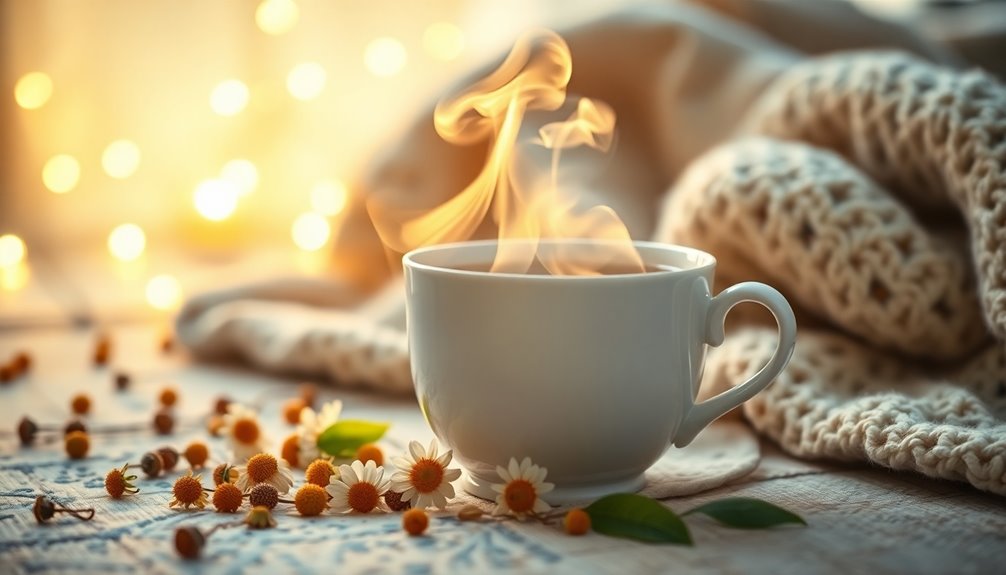Sencha tea is a beloved staple in Japanese culture, known for its diverse varieties and rich flavor profiles. You'll encounter options like Shincha, which offers a sweet taste, and Gyokuro, with its deep umami character. The production process involves handpicking young leaves, followed by steaming to preserve freshness. When brewing, aim for the right temperature to reveal the tea's delicate balance of sweetness, umami, and slight bitterness. Pay attention to freshness and quality indicators like vibrant color and aroma. If you're curious about its health benefits and other details, there's plenty more to explore.
Key Takeaways
- Sencha originated in Japan during the 18th century and became popular due to its accessible production methods and cultural significance.
- Key sencha varieties include Shincha, Gyokuro, Asamushi, Chumushi, and Fukamushi, each offering distinct flavors and characteristics.
- The production process involves handpicking leaves, steaming to prevent oxidation, rolling for shape, and drying to lock in flavor.
- High-quality sencha is indicated by vivid green color, needle-like leaves, and a balance of umami, sweetness, and astringency in taste.
- Brewing sencha requires precise water temperature and steeping time to achieve optimal flavor, differing from matcha preparation methods.
History of Sencha Tea
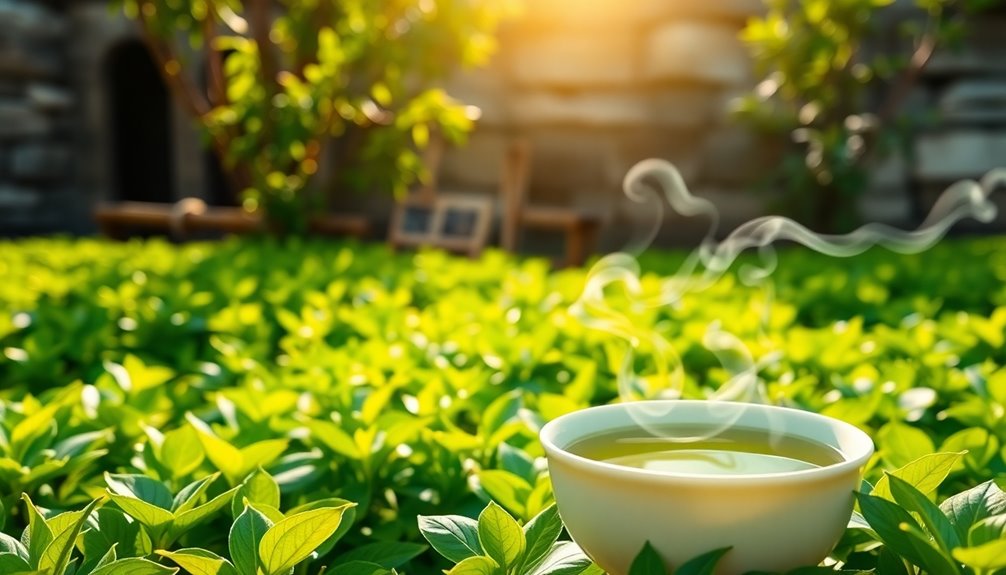
Sencha tea, which gained popularity in Japan during the 18th century, marked a significant shift from the elite preference for matcha to a beverage enjoyed by the common people.
The history of sencha is deeply intertwined with Japanese culture and daily life. Monk Baisao played an essential role in popularizing the brewing method, selling sencha on the streets of Kyoto.
Meanwhile, Nagatani Soen innovated the steaming process, preserving sencha's vibrant green color and enhancing its flavor.
As tea culture flourished during the Edo period, sencha became a staple in Japanese households.
Its cultural significance is celebrated through the sencha tea ceremony, known as Senchado, highlighting the importance of tea in Japanese tradition and everyday rituals.
Varieties of Sencha

While exploring the diverse world of Japanese tea, you'll find that sencha offers a variety of distinct types, each with unique characteristics.
One notable variety is Shincha, the first harvest of the season, known for its sweeter, nuanced flavor.
Gyokuro stands out with its shade-grown leaves, resulting in a rich umami taste and vibrant emerald color.
Asamushi Sencha is lightly steamed, delivering a clean, delicate flavor, while Chumushi Sencha undergoes one minute of steaming for a bolder profile.
Finally, Fukamushi Sencha features longer steaming times of up to two minutes, creating a darker color and reduced astringency.
The diverse steaming times and processing methods greatly alter these flavor profiles, making the varieties of Sencha a favorite among tea enthusiasts.
Quality Indicators of Sencha

When selecting a quality sencha, several indicators can help you determine its freshness and overall excellence. A high-quality sencha exhibits a vivid green color, signaling proper cultivation methods.
The tea leaves should be thin, firm, and twisted, resembling needles, which indicates careful processing. Inhale the aroma; it should combine scents of freshly cut grass and seaweed, enhancing your overall experience.
When brewed, sencha should display a golden-green hue, reflecting its quality and your brewing technique. Finally, the taste should balance deep umami with sweetness and astringency, showcasing well-harvested and processed leaves.
Sencha Production Process
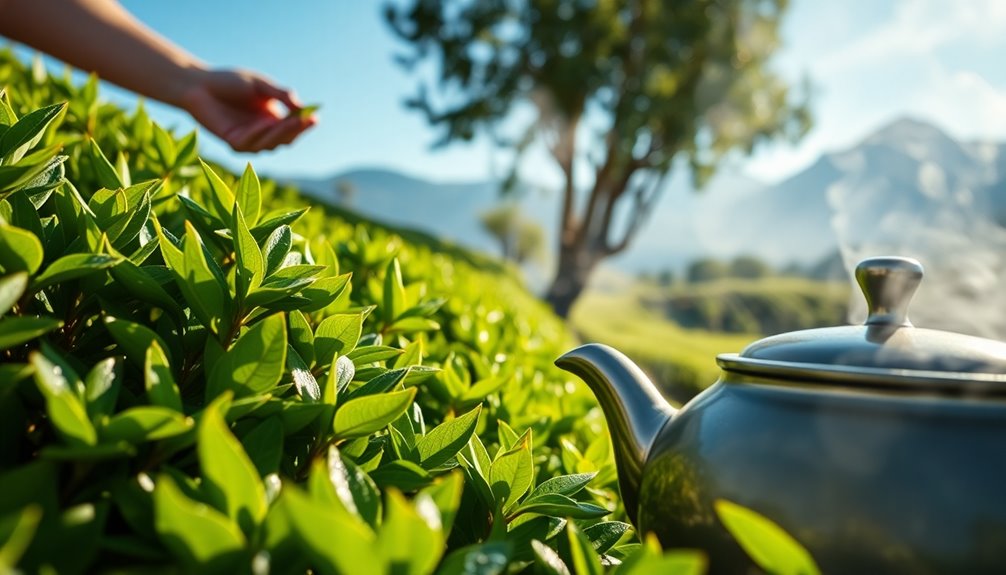
The journey of sencha begins with the careful handpicking of the youngest leaves during the first flush in spring, usually in April, to guarantee peak quality.
Once harvested, these leaves are immediately steamed for 15-20 seconds to prevent oxidation, preserving their vibrant green color and fresh flavor and aroma.
After steaming, the leaves undergo a rolling process, shaping them into the characteristic needle-like form that enhances the release of essential oils.
This meticulous sencha production process culminates in drying the leaves, locking in their unique taste.
Variations in steaming duration create different types of sencha, such as Fukamushi Sencha, which is steamed longer for a richer flavor and darker color.
In fact, sencha accounts for around 80% of Japan's green tea production.
Freshness and Storage Tips
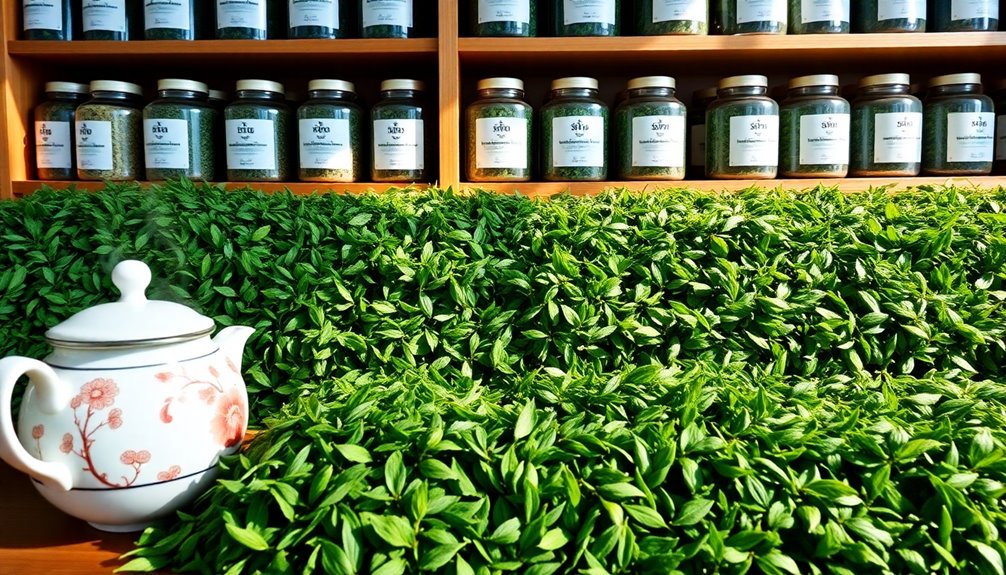
To keep your sencha green tea tasting its best, proper storage is vital. To maintain freshness, store sencha in an airtight, odorless steel container that matches the amount of tea you have, minimizing air exposure.
Unopened packages should ideally go in the refrigerator, while opened teas need a dark place below 70°F to prevent degradation. Proper storage can considerably extend the shelf life of your sencha, even if it's past the best-by date.
Keep it away from light, heat, and moisture to guarantee peak flavor retention. It's also important to avoid strong-smelling substances nearby, as tea can easily absorb odors that might alter its flavor.
Following these tips will help you enjoy your sencha at its finest.
Brewing Techniques for Sencha

Perfecting your sencha brewing technique can elevate your tea experience considerably.
Start by using 1 to 2 teaspoons of sencha leaves per 8 oz of water, adjusting based on the tea's grade. Brew at a lower temperature of 150°F to 170°F for about 1 minute to guarantee smooth flavor extraction without bitterness.
Don't forget to preheat your teaware with hot water before brewing to maintain consistent temperature. You can enjoy multiple infusions—reuse the same leaves, increasing steeping time by 30 seconds for each subsequent brew.
For a revitalizing twist, try cold brewing by steeping 1 to 1.5 teaspoons of sencha in cold water for 4-6 hours in the refrigerator.
Enjoy the diverse flavors your teas can offer!
Health Benefits of Sencha

When you enjoy a cup of Sencha, you’re not just savoring its flavor; you’re also reaping incredible health benefits. Originating from Japan, Sencha is a type of green tea that is rich in antioxidants, known for their ability to reduce the risk of chronic diseases and support overall health. Additionally, its natural caffeine content can provide a gentle energy boost without the crash often associated with coffee. In comparison to the long and tumultuous history of coffee, Sencha has been celebrated for its health benefits for centuries, making it a time-tested and beloved beverage.
Its rich antioxidants, especially catechins like EGCG, can enhance your overall wellness and support heart health.
Regularly sipping Sencha may help lower cholesterol levels and reduce the risk of heart disease, making it a smart choice for your daily routine.
Antioxidant Properties
Sencha green tea stands out for its impressive antioxidant properties, primarily due to its rich content of catechins like epigallocatechin gallate (EGCG).
These powerful antioxidants help combat oxidative stress and reduce inflammation in your body. The high concentration of polyphenols in Sencha enhances its effectiveness in promoting overall health, and it is recognized that whole, unprocessed foods can also contribute significantly to your antioxidant intake.
Regularly enjoying Sencha can improve your immune system, protecting you from illness and disease. Additionally, the antioxidants in this tea may play a role in cancer prevention by inhibiting cancer cell growth and lowering tumor formation risks.
Plus, the L-theanine in Sencha not only promotes relaxation but also boosts the absorption of these antioxidants, maximizing your health benefits with each cup you sip. Furthermore, incorporating chia seeds into your diet can further enhance your antioxidant intake and support overall health.
Heart Health Benefits
The impressive antioxidant properties of Sencha green tea not only support general health but also play a significant role in heart health.
Regularly sipping Sencha can improve cardiovascular health, thanks to its rich polyphenols, particularly catechins. These compounds help lower cholesterol levels and reduce blood pressure, combating oxidative stress that contributes to heart disease.
Additionally, drinking Sencha enhances endothelial function, which is essential for good blood circulation and overall heart wellness.
Research suggests that incorporating Sencha into your daily routines can lead to a 20% reduction in the risk of heart-related problems over time. Furthermore, like coffee, Sencha contains antioxidants that combat oxidative stress, which further supports heart health by protecting against cellular damage.
Sencha Vs Other Teas
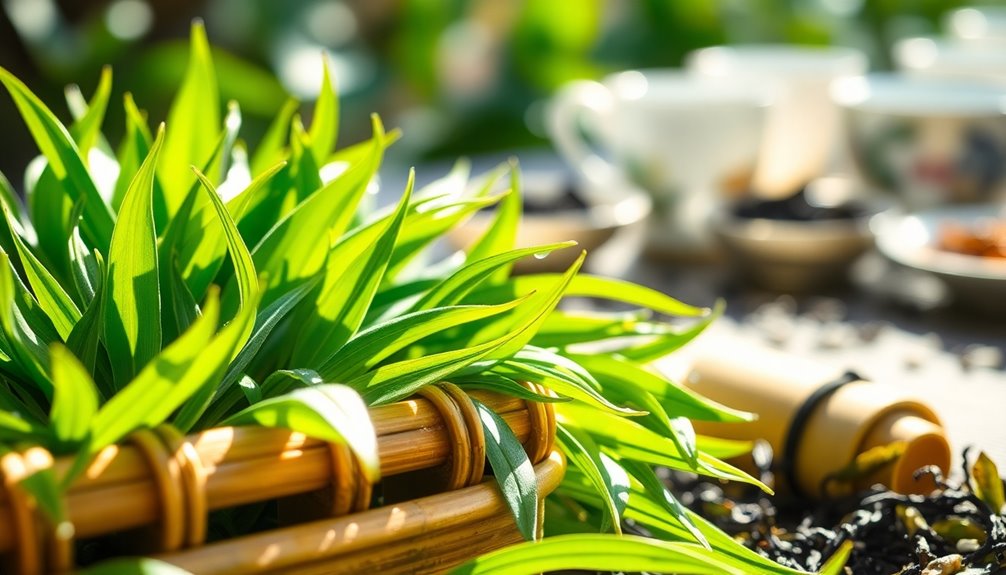
When you compare sencha to other teas, you'll notice some key differences in flavor and preparation.
For instance, while sencha offers a revitalizing vegetal taste, matcha brings a rich, creamy texture due to its powdered form.
Bancha, on the other hand, presents a lighter flavor, making it a great option for a post-meal tea.
Sencha vs. Matcha Differences
While both sencha and matcha are popular green teas, their differences in processing, flavor, and preparation can greatly influence your tea experience.
Sencha is made from whole tea leaves that are steamed, rolled, and dried, while matcha comes from shade-grown Tencha leaves ground into a fine powder.
When brewing sencha, you infuse the leaves in hot water, resulting in a balanced flavor profile of umami, sweetness, and slight bitterness.
In contrast, matcha is whisked into water, giving it a richer, creamier taste with a pronounced vegetal note.
Additionally, matcha generally boasts higher caffeine content since you're consuming the entire leaf, unlike sencha, which has a lower caffeine level due to its brewing method.
Sencha vs. Bancha Quality
Understanding the differences in quality among various green teas can enhance your appreciation for each type.
Sencha is harvested in early spring from the youngest leaves, giving it a higher quality compared to Bancha, which comes from mature leaves collected later in the season. This timing affects the flavor profile considerably; Sencha boasts a vibrant green color and rich umami taste, while Bancha presents a more muted appearance and milder flavor.
Additionally, Sencha typically contains more catechins and antioxidants, offering greater health benefits. Both teas share similar cultivation methods, but the differences in harvest timing and resulting leaf quality create distinct experiences for tea enthusiasts.
When choosing between Sencha and Bancha, you're investing in a unique tea variety. Moreover, the proper brewing techniques can further enhance the flavors and aromas of Sencha, making it an even more rewarding experience.
Flavor Profiles Comparison
Although many green teas share similar characteristics, Sencha stands out with its fresh, grassy flavor and unique umami notes.
When comparing flavor profiles, consider:
- Sencha: A balanced taste with vegetal and oceanic aromas, moderate astringency, and a gentle caffeine boost.
- Bancha: Harvested later, it presents a lighter flavor profile with less astringency, making it a milder option.
- Fukamushi Sencha: Steamed longer, this variety offers a richer, deeper flavor, smoother mouthfeel, and reduced bitterness.
In brewing, Sencha's complexity shines through, while matcha provides a creamier texture and sweetness.
Each tea delivers distinct experiences, but Sencha's umami essence remains unparalleled in the world of Japanese green tea.
Where to Buy Sencha
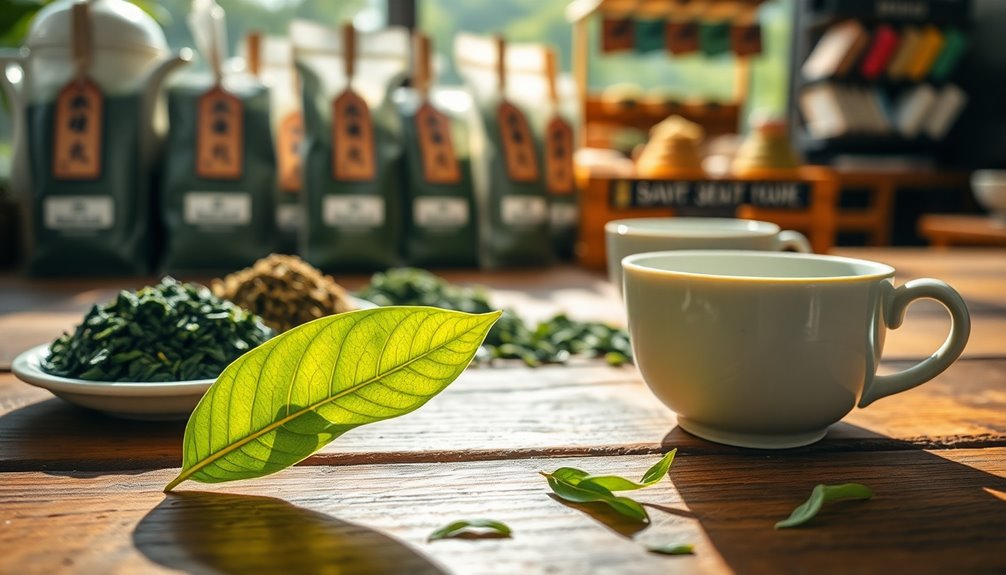
Are you wondering where to buy the best Sencha? You can find sencha green tea in various forms, like loose leaf, tea bags, and bottled options, catering to your preferences. When looking for the best quality, consider reputable brands that focus on sustainability and source their tea from premium farms in Japan. Additionally, if you’re exploring other herbal options, you might be curious about where to purchase asmodev herbal tea, which is known for its unique blend of flavors and health benefits. Whether you prefer the ritual of brewing loose leaf or the convenience of tea bags, there’s a perfect option for everyone.
In Japan, pick up authentic Sencha at convenience stores, supermarkets, or specialty tea shops, where prices vary by grade.
If you're outside Japan, explore local Japanese or Asian grocery stores and reputable online retailers specializing in Japanese green teas. Always check the packaging for the harvest date and grade to guarantee freshness and quality.
For the ultimate experience, source premium Sencha directly from Japanese tea farms or trusted online suppliers, allowing you to savor the finest flavors and varieties this exquisite tea has to offer.
Frequently Asked Questions
Can I Mix Different Sencha Varieties for Brewing?
Absolutely, you can mix different sencha varieties for brewing!
Experimenting with blends can create unique flavors and aromas that suit your taste. Just keep in mind the brewing temperatures and times, as they might vary between varieties.
Start with small amounts to find a balance you enjoy. Remember to take notes on your combinations so you can recreate your favorites later.
It's all about discovering what pleases your palate!
What Are the Common Flavor Notes in Sencha Tea?
Did you know that over 70% of Japan's green tea production is sencha?
When you sip sencha tea, you'll often notice a delightful blend of vegetal, grassy notes, and a hint of umami. Some varieties may even surprise you with sweet or floral undertones.
As you brew, you'll appreciate the crisp, invigorating taste that makes sencha a favorite among tea lovers.
Enjoy exploring these diverse flavor profiles with each cup!
How Does Climate Affect Sencha Tea Flavor?
Climate plays a vital role in shaping the flavor of sencha tea.
When you consider temperature and humidity, you'll notice that warmer climates often yield a sweeter, more vibrant tea, while cooler regions can produce a more robust, grassy flavor.
Rainfall affects the leaf's moisture content, impacting the overall taste profile.
Is There a Difference Between Organic and Non-Organic Sencha?
Yes, there's a difference between organic and non-organic sencha.
Organic sencha is grown without synthetic pesticides or fertilizers, which can lead to a cleaner, more natural flavor. You might notice that organic varieties often have a richer aroma and taste, reflecting the healthier soil and cultivation methods.
Non-organic sencha may contain residual chemicals, which can impact both flavor and health. Choosing organic can enhance your overall tea experience and promote sustainable farming practices.
Can Sencha Tea Be Reused for Multiple Infusions?
Imagine sipping on a cup of steaming tea while reading the latest gossip magazine.
You can definitely reuse sencha tea leaves for multiple infusions! The leaves release their flavors gradually, so you'll enjoy a different taste with each steep.
Just be sure to adjust the steeping time, starting with shorter durations for the second and third infusions.
You'll find it's a delightful way to savor the nuances of your sencha.
Conclusion
In your journey through the world of Sencha, you've uncovered its rich history, diverse varieties, and unique brewing techniques. Imagine savoring a warm cup, the fragrant steam curling around you like a comforting embrace, as you reap its health benefits. Whether you're a beginner or a seasoned tea lover, knowing how to select, store, and brew Sencha elevates your tea experience. So go ahead, indulge in the beauty of Sencha and let each sip transport you to Japan.





